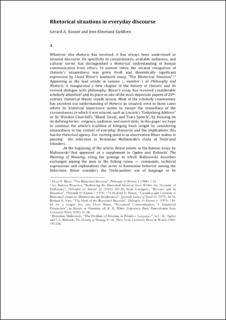Rhetorical situations in everyday discourse
Journal article
Published version

Åpne
Permanent lenke
https://hdl.handle.net/11250/3116111Utgivelsesdato
2010Metadata
Vis full innførselSamlinger
Originalversjon
African Yearbook of Rhetoric. 2010, 1 (1), 91-100.Sammendrag
Whatever else rhetoric has involved, it has always been understood as situated discourse. Its specificity to circumstances, available audiences, and cultural norms has distinguished a rhetorical understanding of human communication from others. In current times, the ancient recognition of rhetoric's situatedness was given fresh and theoretically significant expression by Lloyd Bitzer's landmark essay, "The Rhetorical Situation". Appearing as the lead article in volume 1, number 1 of Philosophy and Rhetoric, it inaugurated a new chapter in the history of rhetoric and its revived dialogue with philosophy. Bitzer's essay has received considerable scholarly attention and its place as one of the most important papers of 20th century rhetorical theory stands secure. Most of the scholarly commentary has enriched our understanding of rhetoric as situated, even in those cases where its historical importance seems to escape the immediacy of the circumstances in which it was uttered, such as Lincoln's "Gettysburg Address" or Sir Winston Churchill's "Blood, Sweat, and Tears Speech", by focusing on its defining terms: exigence, audience, and constraints. In this paper we hope to continue the article's tradition of bringing fresh insight by considering situatedness in the context of everyday discourse and the implications this has for rhetorical agency. Our starting point is an observation Bitzer makes in passing: the reference to Bronislaw Malinowski's study of Trobriand Islanders.
